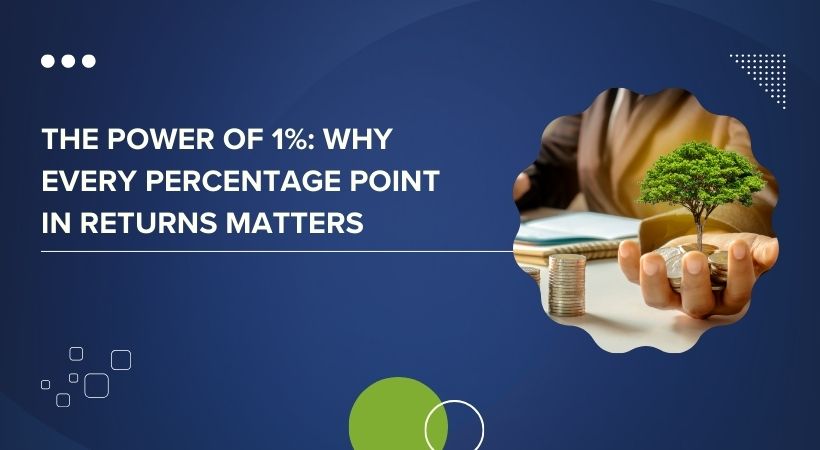When it comes to wealth creation, investors often chase the next big stock idea, the best-performing fund, or the right asset class. But seasoned investors know that over long horizons, it’s not always the big moves—but the small, consistent edges that make the greatest impact.
Let’s talk about the quietest wealth-builder of them all: 1%.
What Does 1% Really Mean?
In investing, a difference of 1% in annual returns might appear trivial in the short run. But when compounded over 10, 15, or 20 years, it becomes the difference between comfort and abundance, especially for high-value portfolios.
Let’s say you invest ₹50 lakhs for 15 years:
Annual Return | Corpus After 15 Years |
10% | ₹2.09 crores |
11% | ₹2.37 crores |
Difference | ₹28 lakhs |
That 1% difference created ₹28 lakhs—without taking more risk, simply by improving return efficiency.
Three Ways to Capture That Extra 1%
- Generating Alpha through Professional Management
Alpha is the excess return a portfolio generates over its benchmark.
In a market where index funds offer 10–11% CAGR, a well-managed portfolio generating even 1% alpha (net of fees) consistently is incredibly valuable.
This alpha doesn’t come from chasing trends—it comes from:
- Smart asset allocation
- Tactical rebalancing
- Behavioral analytics
- Risk-adjusted entry/exit strategies
Such strategies are increasingly available through professionally managed direct mutual fund portfolios, even without active fund picking.
- Saving 1% in Costs with Direct Mutual Funds
A regular plan’s expense ratio is typically 1% higher than its direct counterpart.
By investing in direct mutual funds:
- You eliminate distributor commissions
- Lower costs mean higher net returns
- That saved 1% continues to compound in your favor
For example, a ₹25 lakh investment growing at:
- 10% (regular plan) becomes ₹1.08 crore in 20 years
- 11% (direct plan) becomes ₹1.35 crore
- Gain: ₹27 lakhs
That’s the power of reducing drag on performance.
- Allocating Smarter: 1% Better Rebalancing
Many portfolios underperform not due to bad funds—but due to poor allocation discipline.Timely rebalancing, even once or twice a year, can help:
- Lock in gains from overperforming assets
- Reallocate to undervalued areas (buy low)
- Reduce volatility and preserve capital
Even a marginal 1% improvement in allocation decisions—either through automation or expert oversight—can yield substantial alpha in the long run.
The Power of Layering All Three
While each of these elements—alpha, fee savings, allocation—can individually add 1%, combining them compounds the effect.
Imagine a portfolio that:
- Earns 11% instead of 10% (via better allocation or alpha)
- Saves 1% in fees by going direct
- Avoids emotional missteps by being professionally managed
This layered efficiency leads to not just marginal improvement, but transformational wealth growth.
For HNIs: The Higher the Capital, the Higher the Stakes
For portfolios exceeding ₹50 lakhs or more, even half a percent saved or earned can result in ₹20–50 lakhs in additional value over 15–20 years.
This is why smart investors today are moving toward:
- Fee-efficient, direct mutual fund strategies
- Professional PMS structures using direct funds
- Transparent, long-term aligned advisory models
Conclusion
In investing, it’s easy to overlook the small things in pursuit of the extraordinary. But often, it’s the extra 1%—consistently earned or saved—that creates the extraordinary outcome.
Whether it’s from generating alpha, reducing fees, or optimizing asset allocation, smart investors know that 1% matters.
If you’re managing a sizable portfolio, evaluate your structure. Are you paying more than needed? Are your returns benchmark-aware? A few small optimizations could translate into meaningful long-term gains.
Author: Swapnil Kulkarni
Co-Founder, PriceBridge – A PMS of Ayan Analytics Pvt. Ltd.
With over 17 years of experience in investment advisory and wealth management, Swapnil Kulkarni helps HNIs build cost-efficient, performance-driven portfolios. A CNBC TV18 Financial Advisor Awards nominee (2010), he specializes in delivering long-term alpha through data-backed portfolio strategies and direct mutual fund management.




